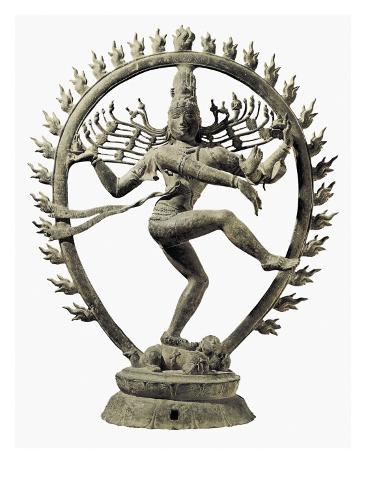

The colors denote all the five elements that create the material world.

The fire and smoke in the background symbolize destruction. The artwork is created based on the above facts showing Lord Shiva is dancing inside the circle of fire of the cosmos. Traditionally, dancers and all other creative artists pray to this form before starting any of their creativity. Shiva is also called Natesa, which means the God of Dance in this role.Hence, he represents that all teachings of right and wrong are also “ignorance” in some form. Apasmara also indicates that nothing is right or wrong, and it all depends on how we use something.For example, lust is a biological need, so we can’t remove it entirely, but we can keep it in check.

Apasmara indicates some of our negativities that can’t be removed entirely but can only be kept in check with mindfulness.
He dances above the body of the dwarf demon, Apasmara, whom he keeps in check but has not killed. The other foot treads firmly upon the dwarf of ignorance, allowing the birth of knowledge. His uplifted left foot grants eternal bliss to those who approach him. The front left hand is across the chest in the Gaja Hasta (elephant trunk) pose, with the wrist limp and the fingers pointed downward toward the uplifted foot. It symbolizes fearlessness towards negative or evil energies. Cobra (snakes) coils down from the right lower arm while the palm is in Abhaya Mudra (meaning refuge or the removal of fear in Sanskrit). The upper left arm holds a fire which symbolizes the force or energy. His upper right hand holds a Damru - a drum shaped like an hourglass. His three eyes symbolize the three Gunas: Satva, Rajas and Tamas. His supreme tranquility amidst continuous creation and destruction is to maintain universal equilibrium. While the Tandava is of destruction, Shiva is calm and smiling. The Circle of Fire ( Prabha Mandala), a closed arch of fire, denotes the cycle of life, which consumes and creates everything. However, the dance of Shiva simultaneously ends one cycle of the cosmos and lays the seed for the creation of a new one. Typically, it is associated with the destructive aspect of creation. Lord Shiva here appears as a Cosmic Dancer. He’s a primary deity in Sanatana Dharma, widely known as the Hindu religion.







 0 kommentar(er)
0 kommentar(er)
